 Crime
Crime  Crime
Crime  Movies and TV
Movies and TV 10 Wildly Different Movie Takes on Nuclear War
 Creepy
Creepy 10 Places Where Folklore Is Alive and Well
 History
History 10 Events That Unexpectedly Changed American Life
 Pop Culture
Pop Culture 10 Cases of Grabbing Defeat from the Jaws of Victory
 History
History 10 Common Misconceptions About the Renaissance
 Weird Stuff
Weird Stuff 10 Crazy Things Resulting from Hidden Contract Provisions
 Facts
Facts 10 Unusual Facts About Calories
 Weird Stuff
Weird Stuff 10 Days of Humiliation When the Person Should Have Stayed in Bed
 Humans
Humans 10 Surprising Ways Game Theory Rules Your Daily Life
 Crime
Crime 10 Truly Evil People Who Used Halloween as the Perfect Cover
 Movies and TV
Movies and TV 10 Wildly Different Movie Takes on Nuclear War
 Creepy
Creepy 10 Places Where Folklore Is Alive and Well
Who's Behind Listverse?

Jamie Frater
Head Editor
Jamie founded Listverse due to an insatiable desire to share fascinating, obscure, and bizarre facts. He has been a guest speaker on numerous national radio and television stations and is a five time published author.
More About Us History
History 10 Events That Unexpectedly Changed American Life
 Pop Culture
Pop Culture 10 Cases of Grabbing Defeat from the Jaws of Victory
 History
History 10 Common Misconceptions About the Renaissance
 Weird Stuff
Weird Stuff 10 Crazy Things Resulting from Hidden Contract Provisions
 Facts
Facts 10 Unusual Facts About Calories
 Weird Stuff
Weird Stuff 10 Days of Humiliation When the Person Should Have Stayed in Bed
 Humans
Humans 10 Surprising Ways Game Theory Rules Your Daily Life
10 Of The Most Absurd Modern Maritime Voyages
If crossing entire oceans on boats of dubious and typically amateurish construction sounds like a risky proposition to you, that’s probably because you’re of a slightly saner disposition than most of the would-be sea captains on this list.
10 Tahiti Nui I (1956)
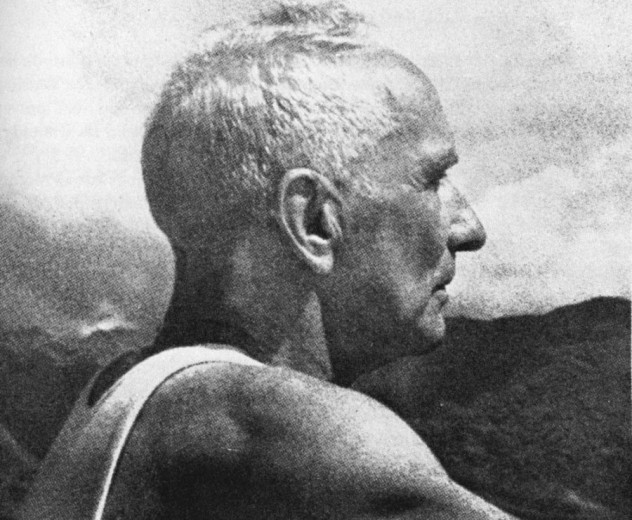
In 1947, Thor Heyerdahl began experimenting with theories of human migration by actually testing those theories out himself. His most famous voyage was the Kon-Tiki Expedition, in which he sailed across the Pacific Ocean in an imitation of an ancient Polynesian raft to prove it was possible.
But the French seafarer Eric de Bisschop didn’t think too highly of Thor Heyerdahl’s idea that Peruvians crossed the Pacific and populated Polynesia. Instead, de Bisschop believed in a massive Polynesian sphere of influence, stretching back thousands of years before Christ and extending as far east as Chile.
So de Bisschop built a raft from Tahitian bamboo and set out to cross the Pacific and prove his theory. To accomplish his goal quickly he sailed south of the 40th parallel, an area better known as the “Roaring Forties” thanks to the region’s almost constant gale-force winds. Experts delicately framed this route as “suicide,” but to everyone’s surprise his raft survived the brutal southern seas and actually handled well in most conditions.
Halfway to South America, de Bisschop’s crew noticed their raft was literally disintegrating due to an infestation of termite-like mollusks called teredos. One hundred ninety-nine days into the trip, the raft began sinking and de Bisschop finally radioed for rescue 240 kilometers (150 mi) off the South American coast.
Undaunted by his initial failure, de Bisschop built a second raft from cypress logs to attempt the voyage again the next year.
9 The Seven Little Sisters (1954)
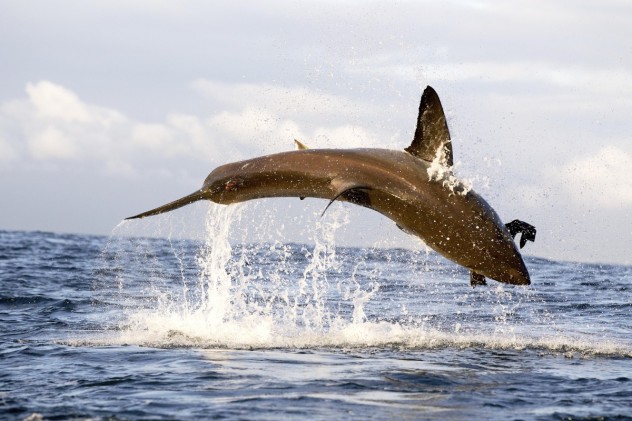
Unlike de Bisschop, William Willis didn’t possess any lofty academic theories—he simply wanted to test his 61-year-old body against the sea. He planned to sail a balsa wood raft solo from Peru to American Samoa, but almost as soon as the journey began, Willis encountered terrible setbacks.
Shortly into his 10,800-kilometer (6,700-mi) journey across the Pacific, nearly all of Willis’ freshwater supply was contaminated. For the majority of his crossing, Willis survived on rainwater, raw flour, condensed milk, and small cups of seawater. During one particularly nasty storm, a large wave tossed a 2.7-meter (nine-ft) shark onto The Seven Little Sisters. Willis fought the shark off and eventually pushed it back into the ocean, but the shark severed an artery in Willis’ forearm—which the sailor somehow managed to suture himself.
But nothing could compare (in Willis’ mind, anyway) to the horror of losing his feline travel companion. Which is why each time rough seas threw Willis’ cat overboard, the grizzled old sailor flung himself after it and, without so much as a rope or life preserver, swam against the full force of the Pacific Ocean to rescue his friend.
Miraculously, Willis, his cat, and his living-room-sized raft reached American Samoa perfectly intact after having traveled 3,200 kilometers (2,200 mi) farther than Thor Heyerdahl’s Kon-Tiki. For an encore, at age 70, Willis sailed a raft from South America to Australia—a journey of 17,700 kilometers (11,000 mil).
8 Ra II (1970)
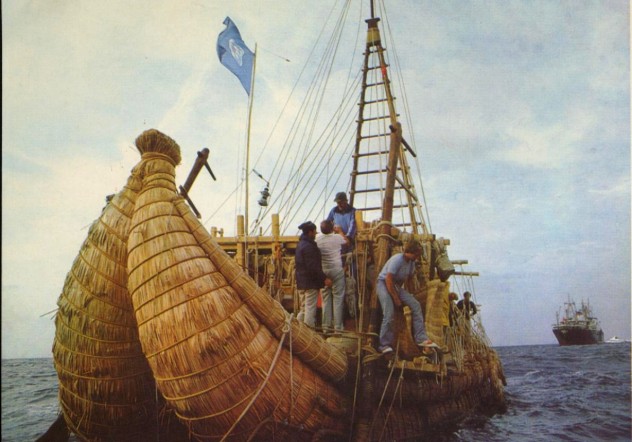
Thor Heyerdahl was no one-hit wonder. After crossing the Pacific to test his theories on Peruvian migration, the Norwegian set his sights on the Atlantic and perhaps an even more ancient maritime tradition.
It was widely assumed that ancient Egyptian ships made from papyrus were capable only of river navigation and coastal travel because the rough seas of blue-water sailing would surely destroy such a fragile vessel. Thor proved all of those critics right when Ra I’s inaugural journey from Africa to the Americas ended with the ship taking on water and breaking apart.
But Heyerdahl and his crew weren’t discouraged. They built a second boat from papyrus reeds—this time with input from Bolivian raft makers accustomed to building similar boats on Lake Titicaca.
On Ra II, Heyerdahl successfully sailed from Morocco to Barbados (6,450 km/4,000 mi) in 57 days. The voyage was especially impressive considering the ship he built lasted more than four times as long as scholars had predicted.
7 The Acali (1973)
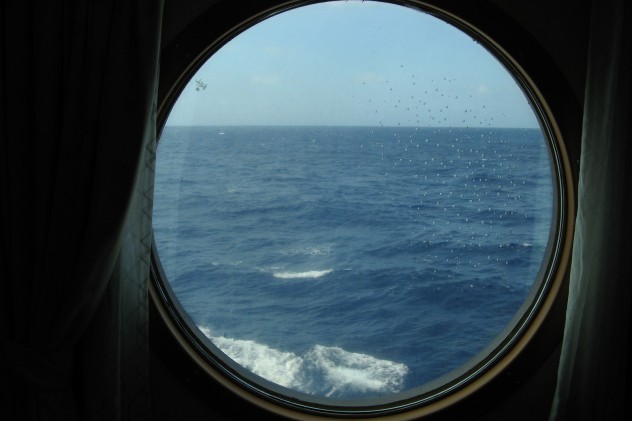
“Eleven strangers, picked to live on a raft.” If that sounds familiar, minus the whole raft thing, it’s because Santiago Genoves beat The Real World creators to the punch by two decades. While working with Thor Heyerdahl on the Ra expeditions, Santiago Genoves concluded that a small raft would be the perfect laboratory to study human behavior—after all, subjects can’t hide a whole lot from researchers on a 12×7-meter (40×23-ft) raft.
Sometimes sailor, but all-the-time anthropologist, Genoves picked five male and six female volunteers from various cultural backgrounds. We’re not joking about the “all-the-time” part, either: over the 101-day journey from the Canary Islands to Mexico, Genoves compiled over 8,000 questions and responses from his subjects into a massive ethnology.
Despite the dearth of sailing experience among the volunteers, the Acali survived incredible setbacks like attempted suicides, serious illnesses, hurricanes, and shark attacks. Unsurprisingly, given the young volunteers’ darkening tans and increasing fitness over the course of the voyage, The Acali took on aspects of a floating orgy as the volunteers whittled away their boredom working out varying sexual arrangements.
Seriously, The Real World probably owes Genoves a royalty check.
6 Excalibur (1981)
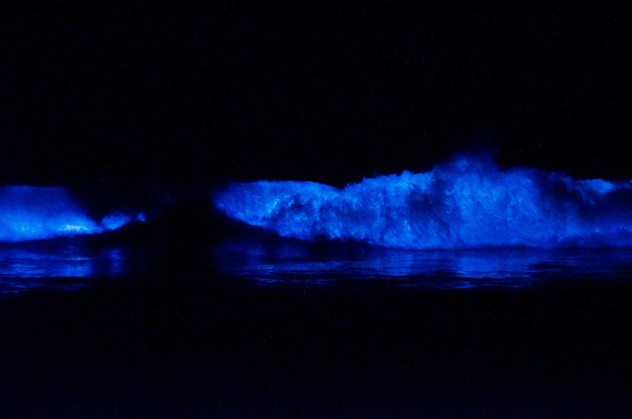
Curtis and Kathleen Saville loved a challenge, which is why they decided to conduct an oceanic survey by rowing across the Atlantic Ocean. The Savilles departed Morocco only to be immediately pushed off course by a storm, forcing them to row through the war zone just off the coast of Spanish Sahara. But once the Savilles made it to open ocean, the small size of Excalibur enabled them to easily collect frequent samples of small oceanic life supported by human pollution.
At only 7.6 meters (25 ft) in length, the Excalibur was small enough to allow waves to crash right over their deck, allowing the couple to easily spot bioluminescent (glowing) creatures. The couple recorded far more instances of this type of creature than land-lubber researchers could have anticipated.
The Savilles arrived safely in Antigua after 83 days of near constant rowing.
5
The Phoenicia (2007)
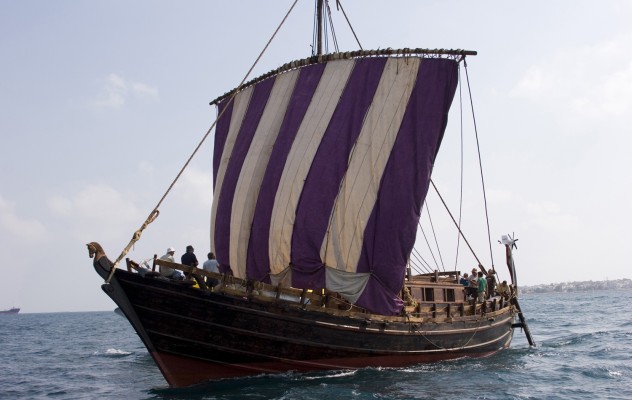
In 600 B.C., the Greek historian Herodotus wrote of a group of Phoenicians (from the area of modern-day Syria/Lebanon) who circumnavigated Africa in three years. Ever since, scholars have debated the possibility of such a trip, as the next known African circumnavigation didn’t occur until 1488. The source of the doubt is simple: in order to make any headway, the Phoenician’s simple galleys would have required winds almost directly behind the ship for the whole passage.
In 2007, Philip Beale, a fund manager turned adventurer/historian/anthropologist, wanted to confirm Herodotus’ story. Beale commissioned a ship built to the specifications of a recently uncovered ancient Phoenician galley wreck. With no modern concessions except a tiny engine to avoid having to be towed in and out of harbors, Beale was left with an authentic ship that sailed just as well as its ancient predecessor: poorly. Without perfectly favorable winds, The Phoenicia handled like a bathtub.
The ship’s problems seemed endless. In an attempt to steer the ship, Beale broke nine rudders. At one point, storms tore the ship’s sail in two. The 11-man crew perpetually bailed the leaky ship just to stay afloat (and alive). And since Beale made no concession for modern winches or pulleys, the crew of 11 pulled yard and sail by hand.
Two years and over 17,000 miles later, Beale and crew managed to complete their trip by sailing through the pirate-infested Gulf of Aden, narrowly avoiding modern versions of the scurvy jerks that likely beset the original Phoenician voyage.
4 Cork Boat (2002)

John Pollack realized from the get-go that it was somewhat absurd, but President Clinton’s former speechwriter still had a dream to construct a boat entirely out of corks: 165,321 individual wine corks to be exact.
It took two years of planning, testing, and labor, but he finally lashed together the thousands of corks using an ingenious netting system. The result? A Viking-esque longboat that, while buoyant, was as awkward and as clumsy to handle as a “hippopotamus.” All of which simply made Cork Boat’s journey through Portuguese wine and cork country that much more challenging (Portugal is the largest supplier of cork in the world).
Pollack and several volunteers spent over two weeks rowing down the Douro River to the sea. With the occasional tow to help maneuver through the river’s locks system, the Cork Boat completed its journey almost entirely intact.
3 Starkell’s Canoe (1980-1982)

Before he passed away, Don Starkell claimed to have paddled more miles than any other man, ever—and we’re inclined to believe him. In a single trip, Starkell added 12,000 miles to his total. With their sites set on South America, Starkell and his two sons launched their 6.4-meter (21-ft) canoe from their Winnipeg home in 1980.
Via the Red River, Mississippi, the Gulf of Mexico, the Orinoco and finally the Rio Negro, the two Starkells paddled their open canoe all the way to the mouth of the Amazon. One of Starkell’s sons, Jeff, abandoned ship in Mexico after one too many scrapes with death. And there were a lot of close calls.
Hostile wildlife like snakes and sharks were certainly dangerous, but were ultimately the least of Don Starkell’s worries. Nicaraguan rebels, drug runners, and Honduran robbers proved far more dangerous to the paddlers. Thirteen countries, 45 holings, and at least 15 capsizes later, the Starkells arrived at the mouth of the mighty Amazon River.
But officials had trouble believing the Canadians’ harrowing story. Starkell pulled together passports and visas, detention documents from his “stay” in Nicaragua, a Venezuelan TV interview and letters from various embassies. Sufficiently convinced by the haggard paddlers waving stacks of paperwork, Guinness entered the journey as the longest canoe trip ever made—at 12,000 miles from Winnipeg to Brazil.
2 Lehi IV (1958)
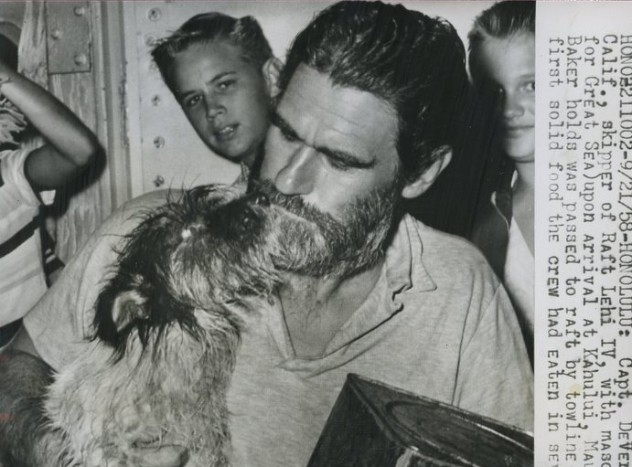
The 1950s saw raft-based anthropology reach an all-time high. Theories concerning pre-Columbian colonization of the Americas were a dime a dozen, as were eccentrics willing to pilot dubious maritime crafts in order to back up various theories.
Devere Baker was one such eccentric. After reading the Book of Mormon, Baker really wanted to prove that Israelites sailed from the Red Sea to Central America and colonized the New World. Utilizing no archaeological evidence whatsoever, Baker began building rafts to test his theories. Notice the “IV” after the “Lehi”: Baker’s first three rafts were failures. But on his fourth attempt, Baker finally created a wood platform that actually floated—even if it was impossible to control.
Despite his vessel’s quality issues, Baker charted a course from Redondo Beach to Hawaii, which raises the obvious question: “What does that have to do with Israel and Central America?” The answer is nothing.
Pointlessness of the journey aside, the fact remains that incredible luck, favorable winds, a complete lack of serious storms, and a small crew of college students helped make this Hawaiian voyage a reality. Oh—another key source of help was the Coast Guard cutter that helped finish the trip by towing the Lehi IV to shore.
The Lehi IV did nothing at all to advance anthropological scholarship, but Baker certainly cemented his legacy when his wife wrote a book about the journey—from the perspective of a dog that had sailed with them.
1 Tahiti Nui II-III (1958)
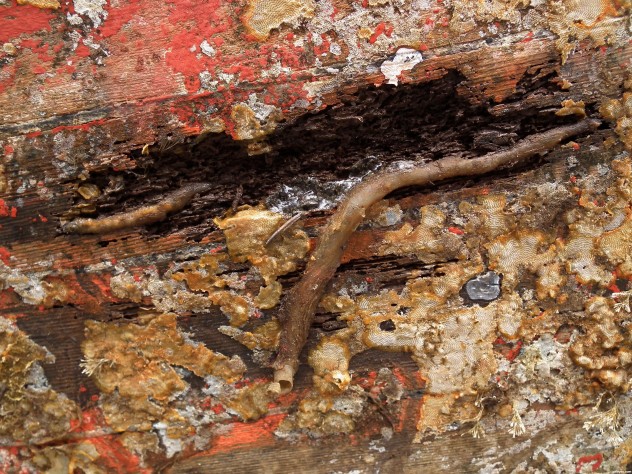
Eric de Bisschop didn’t just give up after the failure of Tahiti Nui. No, he put together a new raft made from cypress and balsa logs which he then launched from Chile with every intention of sailing to Polynesia.
The five-man team cruised along happily—at first. By June, just two months into the trip, Tahiti Nui II had sunk 20 centimeters (eight inches). By the end of June, the raft was riding a full meter (3.3 ft) lower, and the crew was forced to take refuge on the raft’s cabin’s roof. While still almost 650 kilometers (400 mi) away from the next possible landfall at the Marquesas Islands, the crew discovered why the vessel was sinking: teredos (again!) had burrowed countless holes through the raft’s logs.
Increasingly disgruntled crew members plotted solo escapes as supplies dwindled and fever immobilized de Bisschop. By August, the raft was only 240 kilometers (150 mil) closer to land and just barely floating, but de Bisschop had recovered and now had a plan: the Tahiti Nui III.
Insane as it was, a smaller raft using the few remaining hole-free logs and water barrels was the best chance the crew had to survive. Over the course of one week, the crew struggled to build the new raft while keeping the old one at least somewhat afloat. They succeeded. The Tahiti Nui III’s deck was just 1.5×1.8 meters (5×6 ft), but the pathetic little craft floated and the crew clung desperately to her as she rocked violently through the rough seas toward safety.
The Tahiti Nui III made landfall in the Cook Islands, but unfortunately, de Bisschop didn’t survive the raft’s destruction on a reef. However, thanks to his remarkable ingenuity, his crew made it to land and was eventually rescued.








